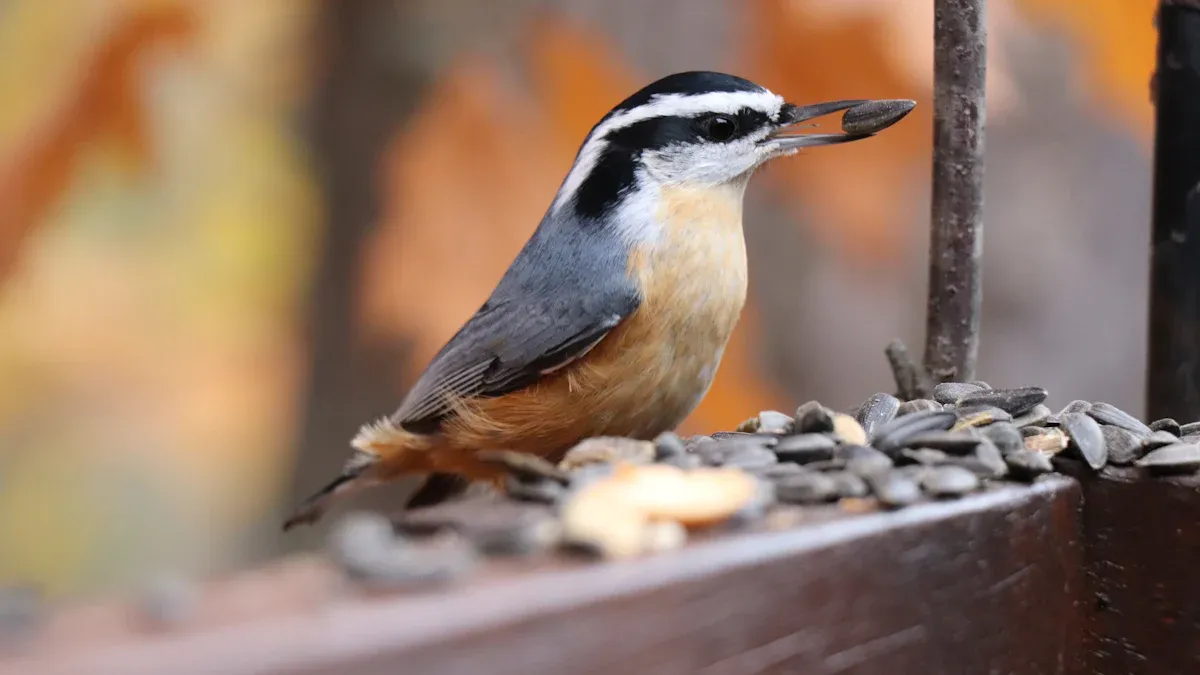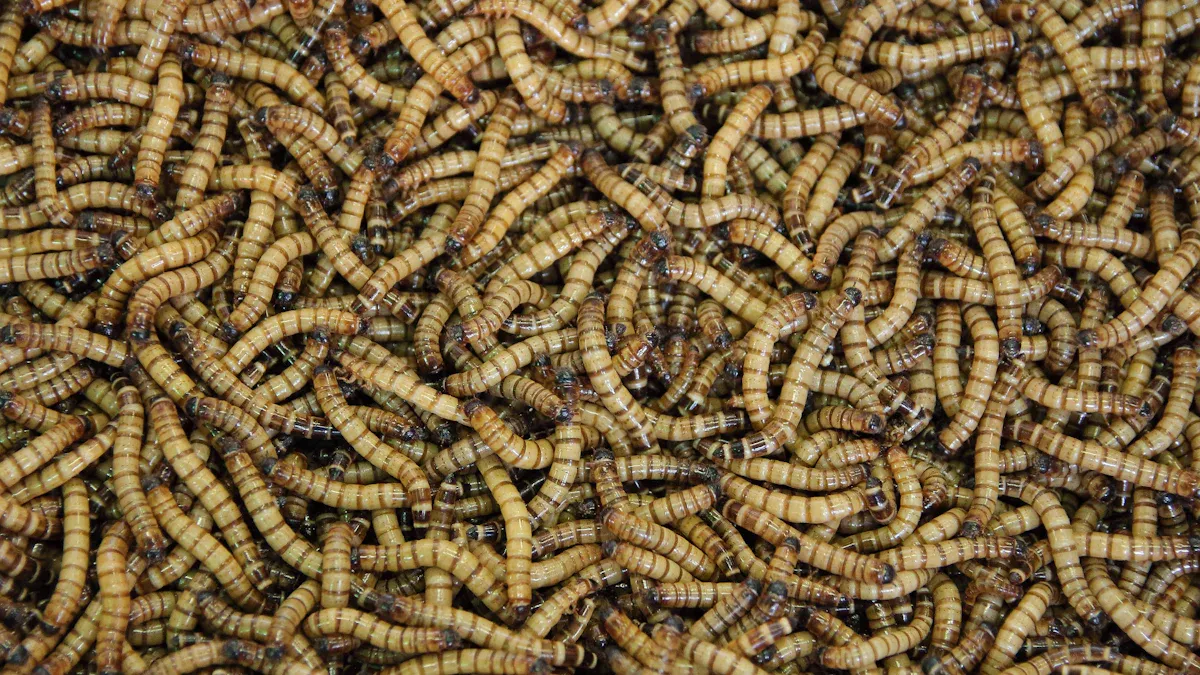
Dried mealworms have become a favorite among bird enthusiasts, and it’s easy to see why. They pack a punch with 59.2 g of protein per 100 g, far surpassing alternatives like soybean meal. Plus, their market is booming, projected to hit USD 17.66 million by 2031. Meal Worm Bird Food offers unmatched nutrition and convenience.
Key Takeaways
- Dried mealworms are rich in protein (59.2g per 100g). They also have important nutrients, making them great for birds. They are especially helpful during nesting and migration times.
- Mealworms are simple to use in feeders and not messy. They can be kept for a long time, which makes them handy for bird lovers.
- Adding mealworms to other bird foods can bring more bird types. This improves birdwatching and helps meet different birds’ food needs.
Nutritional Benefits of Meal Worm Bird Food

Protein, Fat, and Fiber Content
Meal Worm Bird Food is a powerhouse of nutrition. It boasts an impressive 59.2 grams of protein per 100 grams, making it a top choice for birds that need energy for flying, nesting, or raising chicks. Alongside protein, it contains 24 grams of fat and 9.3 grams of fiber, which help birds maintain healthy feathers and digestive systems. Compared to soybean meal, mealworms offer significantly higher fat content, which is essential for birds during colder months when they need extra energy.
Here’s a quick comparison:
| Item | Mealworm Meal | Soybean Meal |
|---|---|---|
| Dry Matter (g) | 95 | 90 |
| Crude Protein (g) | 59.2 | 44 |
| Crude Fat (g) | 24 | 0.5 |
| Crude Fiber (g) | 9.3 | 7.0 |
Comparison to Seeds and Suet
Mealworms stand out when compared to traditional bird foods like seeds and suet. While seeds are rich in carbohydrates and suet provides fat, mealworms deliver a balanced mix of protein, fat, and fiber. Birds benefit from this combination, especially during breeding or migration seasons. Plus, mealworms have a unique mineral profile that can be enhanced by their diet, making them even more nutritious.
Addressing Nutritional Gaps (e.g., Calcium)
Calcium is crucial for birds, especially for egg-laying females and growing chicks. Dried mealworms can help fill this gap. Studies show that supplementing mealworms with calcium-rich feeds boosts their nutritional value. This makes Meal Worm Bird Food an excellent choice for supporting bone health and overall development in birds.
🐦 Tip: Consider offering mealworms during nesting season to help birds meet their calcium needs!
Birds Attracted to Meal Worm Bird Food
Species That Favor Mealworms
Mealworms are a magnet for many bird species. You’ll often see bluebirds, chickadees, thrushes, titmice, wrens, nuthatches, and kinglets flocking to feeders stocked with Meal Worm Bird Food. These birds love the high protein and fat content, which gives them the energy they need for their daily activities.
Here’s a quick list of birds that favor mealworms:
- Bluebirds
- Chickadees
- Thrushes
- Titmice
- Wrens
- Nuthatches
- Kinglets
If you’re hoping to attract these species to your yard, mealworms are a great choice.
Seasonal and Migratory Preferences
Birds’ preferences for mealworms can change with the seasons. During migration, species like robins and garden warblers may consume mealworms sparingly, as studies show they rarely eat more than 6 grams even when offered 8 grams. This behavior mimics their natural refueling habits.
| Bird Species | Mealworms Consumed | Conditions of Study |
|---|---|---|
| Robins | Rarely ate > 6g | Provided with 8g of mealworms to simulate natural refueling opportunities at the site |
| Garden Warblers | Rarely ate > 6g | Similar conditions as Robins, focusing on mealworms only |
| Previous Studies | Varied food types | Used mixtures of dry insect food, banana, and boiled egg instead of just mealworms |
Mealworms are especially popular during nesting season when birds need extra protein for their chicks. Offering Meal Worm Bird Food during this time can make your yard a haven for feathered families.
Comparison to Birds Attracted by Other Foods
Mealworms attract a different crowd compared to other bird foods. Seeds and suet tend to draw sparrows, finches, and woodpeckers, while mealworms appeal to insect-loving species. The nutritional profile plays a big role here. Mealworms have lower carbohydrate content (<1%) compared to mixtures like dry insect food, banana, and boiled egg, which contain 7.7%.
| Food Type | Lipid Content (%) | Carbohydrate Content (%) |
|---|---|---|
| Mealworms | 8.2 | <1 |
| Mixture (dry insect food, banana, boiled egg) | 19.0 | 7.7 |
If you want to attract a diverse range of birds, consider mixing mealworms with other foods. This way, you’ll cater to both insectivores and seed-eaters.
Practical Considerations for Meal Worm Bird Food
Ease of Use in Feeders
Mealworms are incredibly easy to use in bird feeders. Unlike messy alternatives, they’re clean and simple to handle. You can pour dried mealworms directly into a feeder without worrying about spills or sticky residue. Experts recommend starting with live mealworms to attract birds, then switching to dried ones for convenience. Dried mealworms also hold up well in different weather conditions, so you can use them year-round without hassle.
If you’re new to feeding birds, mealworms are a great choice. They’re less likely to clog feeders compared to suet or seed mixes. Plus, they’re lightweight, making them easy to carry and refill.
🐦 Tip: Use a feeder with a tray or dish to keep mealworms contained and accessible to birds.
Storage and Shelf Life
Proper storage is key to keeping your dried mealworms fresh. Store them in a cool, dark place, like a cabinet or pantry, to prevent spoilage. For longer shelf life, refrigerate or freeze them in a tightly sealed bag. This can extend their freshness for up to a year. If refrigeration isn’t an option, they’ll still last up to six months in a tightly sealed container.
A clear, smooth-sided container works best for storage. It prevents pests from getting in and makes it easy to monitor the condition of your mealworms. Avoid small containers, as they can trap heat and reduce freshness.
Cost vs Value
Dried mealworms might seem pricey at first, but they offer excellent value. Their high nutritional content means you don’t need to use as much compared to other bird foods. Plus, their long shelf life reduces waste, saving you money in the long run.
Here’s a quick look at how cost and value are measured:
| Metric | Description |
|---|---|
| Feed Cost | Reflects the price of ingredients used in production. |
| Cost Benefit Ratio (CBR) | Shows the economic efficiency of using mealworms compared to other bird foods. |
| Return on Investment (RoI) | Indicates the financial return you get from investing in mealworms for bird feeding. |
When you consider the benefits, Meal Worm Bird Food is a smart investment for attracting and nourishing birds in your yard.
Tips for Using Meal Worm Bird Food Effectively
Choosing the Right Feeder
Selecting the right feeder can make a big difference in attracting birds to your yard. A hanging platform feeder works well for dried mealworms, as it provides easy access for various species like bluebirds and chickadees. If you’re dealing with unwanted visitors like starlings, consider using a Squirrel Buster feeder. It slows down larger birds, giving smaller ones a chance to enjoy the mealworms.
Birds may need time to adjust to a new feeder. Place it in a visible spot and sprinkle a few mealworms around the area to guide them. Bluebirds and wrens, for example, might hesitate at first but will eventually learn to use the feeder. Patience is key!
🐦 Tip: Choose a feeder that can withstand extreme weather to keep your Meal Worm Bird Food fresh and accessible year-round.
Rehydrating Dried Mealworms
Rehydrating dried mealworms can make them even more appealing to birds. Soak them in lukewarm water for about 10-15 minutes before placing them in the feeder. This process softens the mealworms, mimicking the texture of live insects. Birds like robins and thrushes, which prefer softer food, are more likely to visit your feeder when you offer rehydrated mealworms.
Rehydration is especially helpful during nesting season. Parents need soft, easy-to-digest food for their chicks. Plus, soaking mealworms in nectar or water can add extra hydration, which is beneficial during hot weather.
🐦 Tip: Don’t soak more mealworms than you plan to use in one feeding session to avoid waste.
Mixing Mealworms with Other Foods
Mixing mealworms with other bird foods can attract a wider variety of species to your yard. Combine them with seeds to cater to both insectivores and seed-eaters. For example, chickadees and cardinals enjoy this combination. During colder months, adding mealworms to suet can provide birds with the extra energy they need to stay warm.
A balanced mix of foods not only supports birds’ nutritional needs but also enhances your birdwatching experience. You’ll likely see a greater diversity of species visiting your feeder.
🐦 Tip: Start with a small ratio of mealworms to seeds, then adjust based on the birds’ preferences in your area.
Dried mealworms offer unmatched benefits for bird feeding. Their high protein content (40.7%–52.3%) and essential minerals like calcium and iron make them a nutritional powerhouse. They’re easy to store, versatile, and attract a variety of species. Start small, experiment with feeders, and watch your yard transform into a bird haven! 🐦
FAQ
What’s the best way to store dried mealworms?
Keep them in a cool, dry place. Use airtight containers to prevent moisture. Refrigeration extends freshness up to a year.
🐦 Tip: Avoid direct sunlight to maintain quality.
Can dried mealworms attract unwanted pests?
Yes, if stored improperly. Seal containers tightly and keep them away from damp areas to avoid attracting ants or moths.
How often should you feed birds dried mealworms?
Offer mealworms daily during nesting or migration seasons. Adjust based on bird activity in your yard.
🐦 Note: Overfeeding can lead to waste. Start small and observe bird preferences.


